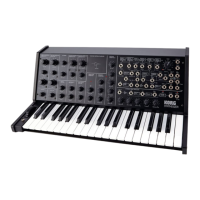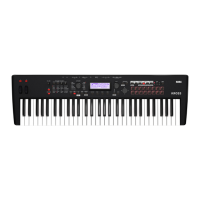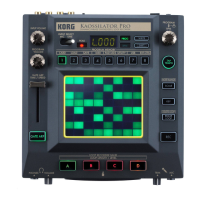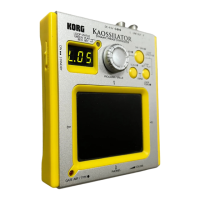-
32 -
KingKORG Parameter Guide
MIDI
2.
Channels and messages
MIDI channels
MIDI has sixteen channels, 1–16.
If the MIDI channels of the transmitting and receiving device match, MIDI
messages can be sent and received between those devices. The KingKORG
uses two types of MIDI channels, which you can specify as follows.
Global MIDI channel
This is the basic MIDI channel used by the KingKORG to transmit and receive
data.
Your performance and user input on the KingKORG will be transmitted on this
channel. The KingKORG will also respond to messages sent from an external
MIDI device on this channel. To set the global MIDI channel, change the
GLOBAL “g16: MIDI Basic” page Global Ch setting (→ p.18) to the desired
channel.
Timbre B MIDI channel
Of the KingKORG’s two timbres, timbre B can be set to receive a channel
that’s different than the global MIDI channel.
For example, this lets you adjust settings so that you can use an external MIDI
keyboard to play only timbre B. To set the timbre B MIDI channel, change the
PROGRAM “p04: Common” page Timb B Ch (→ p.4) to the desired
channel for each program.
You can’t adjust this setting if timbre B is unavailable. To enable timbre B,
set the program’s “p03:Common” page VoiceMode parameter
(→ p.3) to “Layer” or “Split”.
The KingKORG’s timbre B MIDI channel is only for receiving data.
Playing the KingKORG’s keyboard will not transmit on this channel.
MIDI messages
Various types of MIDI messages are sent and received to indicate the
beginning or end of notes, the selection of a program, and control of the sound.
The following section explains the main types of MIDI message used by the
KingKORG.
Note-on/Note-off
A note-on message indicates the beginning of a note, and a note-off message
indicates the end of a note.
The KingKORG transmits a note-on when you press a key, and a note-off
when you release the key. When the KingKORG receives a note-on message,
its internal sound generator will produce sound corresponding to the note
number and velocity of that note-on. When it receives a note-off message, that
sound will turn off.
Note-on [9n, kk, vv]
Note-off [8n, kk, vv]
(n: channel, kk: note number, vv: velocity)
The KingKORG does not support note-off velocity. All note-off messages
it transmits are sent with a fixed velocity value of 64, and any note-off
velocity value it receives will be ignored.
TIP:
You can transmit the notes that are generated by the arpeggiator. If the GLOBAL “g03:
Common” page Position parameter (→ p.16) is set to “PostKBD,” note-on/off mes-
sages generated by the arpeggiator will be transmitted.
Switching programs and timbres
To switch programs (sounds), you’ll use bank select and program change
messages to specify the bank and program numbers.
In addition to switching programs, the KingKORG also uses these messages
to switch timbres.
Bank select MSB (CC#00) [Bn, 00, mm]
Bank select LSB (CC#32) [Bn, 20, bb]
(n: channel, mm: upper byte of the bank number, bb: lower byte of the bank number)
Program change [Cn, pp]
(n: channel, pp: program number)
Transmitting a bank select message by itself has no effect.
After transmitting a bank select message, you must follow it with a
program change message.
Switching programs
When you switch programs on the KingKORG, bank select and program
change messages are transmitted. When the KingKORG receives these
messages, it will switch to the correspondingly numbered program.
If only a program change message is received, the KingKORG will switch to
the correspondingly numbered program in the most recently selected bank.
For example if program 183 is currently selected and program change number
15 is then received, the KingKORG will switch to program number 115 which is
the corresponding number within the currently selected bank of 101–200.
Bank MSB
(CC#00)
Bank LSB
(CC#32)
Program Change
Corresponding
numbers
00 00
001–100
001–100
00 01 101–200
00 02 201–300
If you want to use separate MIDI channels to control timbre A and timbre
B in the program newly selected by a program change, you must save
that program beforehand with the appropriate MIDI channel specied for
timbre B.
TIP:
You can adjust settings so that bank select messages will not be transmitted or received.
To do this, set the GLOBAL “g24:MIDI Filter” page BankChg parameter (→ p.19) to
“Disable”.
TIP:
You can adjust settings so that program change messages will not be transmitted or
received. To do this, set the GLOBAL “g23:MIDI Filter” page ProgChg parameter
(→ p.19) to “Disable”.
Switching timbres
The KingKORG lets you switch a timbre in the currently selected program to
the timbre settings of a different program.
When the following bank select and program change messages are received,
the timbre of the corresponding program will be loaded into the current timbre.
Bank MSB
(CC#00)
Bank LSB
(CC#32)
Program Change Corresponding numbers
32 32
001–100
001–100 / Timbre A
32 33 101–200 / Timbre A
32 34 201–300 / Timbre A
32 35 001–100 / Timbre B
32 36 101–200 / Timbre B
32 37 201–300 / Timbre B
When you switch the timbre, the settings of the s01–s80 page
parameters will be loaded into that timbre; the effect, arpeggiator, and
vocoder settings will not be loaded.
TIP:
The timbre settings will be loaded into the timbre of the matching channel. If the Timbre
B Ch is enabled and is different than the global MIDI channel, this lets you load the set-
tings into either timbre A or timbre B.
Controlling the sound
Dynamically changing the pitch
When you move the joystick to the left or right, the KingKORG will transmit
pitch bend messages.
When pitch bend messages are received, the pitch will change dynamically
according to the bend range setting specified by the PROGRAM “s09: Pitch”
page BendRange parameter (→ p.5).
Pitch bend change [En, bb, mm]
(n: channel, bb: lower digits of value, mm: upper digits of value)
Upper byte
value
Lower byte
value
Pitch bend value
Actual pitch
(BendRange=+2)
Control source
value
127 127 8191 +2 +127
64 00 0 0 0
00 00 –8192 –2 –127
TIP:
You can use pitch bend as a control source in a virtual patch (→ p.12) or in the
vocoder (→ p.13).
TIP:
The KingKORG also lets you control the pitch using the control change messages
described in the following section.

